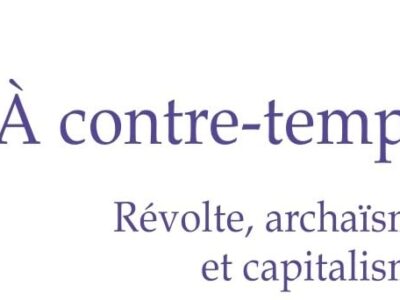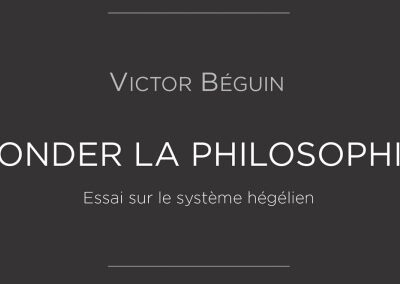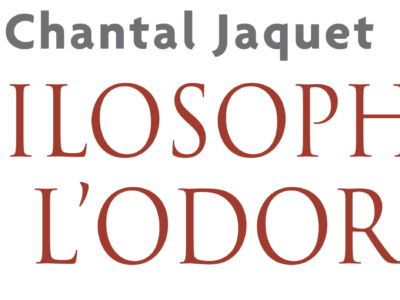Heritable human genome editing: the bioethical battle for the basis and future of human rights
Niall Coghlan, Ph.D. Researcher in EU fundamental rights and biolaw, European University Institute (EUI), Florence; Barrister, Lincoln’s Inn, London, and King’s Inns, Dublin; email: niall.coghlan@eui.eu.
Résumé
Peut-on interférer avec le génome des futurs humains ? Des avancées récentes – telle que la naissance alléguée des premiers enfants modifiés génétiquement en 2018 – ont ranimé ce débat récurrent dans le champ des droits humains. Cet article commence par résumer l’interdiction de telles ingérences en droit international des droits humains (DIDH), mais aussi les arguments « conservateurs » qui les justifient, ainsi que leur critique « libérale ». Ensuite, il développe deux arguments. Premièrement, ce débat est étayé par une différence de conceptions quant à la finalité, le fondement et les limites des droits humains eux-mêmes. Chacune des positions mobilise la pratique existante du DIDH, tout en appelant à une évolution radicale de cette même pratique. De ce fait, les interdictions ne seraient pas conçues comme des droits individuels ou collectifs, mais plutôt comme des dispositions d’« autodéfense », similaires à celles relatives aux abus et aux dérogations. Cette perspective aiderait à clarifier le débat. Deuxièmement, le langage des droits de humains peut se révéler inadapté pour appréhender ce débat, notamment parce qu’il ne permet pas d’aborder pertinemment certains enjeux existentiels. L’article conclut par quelques réflexions sur l’adéquation des droits humains pour répondre aux questions relatives au futur à long terme de l’humanité.
Mots-clés : édition génétique – bioéthique – droits humains – droit – futur de l’humanité
Abstract
Is it permissible to interfere with the genome of future humans? Recent advances – including the alleged birth of the first genome-edited babies in 2018 – have brought fresh vigour to this long-standing human rights debate. This article first summarises the existing international human rights law (IHRL) prohibitions on such interference, the ‘conservative’ arguments that justify it, and the ‘liberal’ critique of the same. It then develops two arguments. First, this debate is underpinned by a clash of visions as to the orientation, basis and limits of human rights themselves. Each side draws on a strand of existing IHRL practice, but each requires radical transformation of that practice. Given this, the prohibitions are best understood not as individual or collective rights, but rather as ‘self-defence’ provisions analogous to abuse or derogation clauses. This understanding may help clarify and unblock the debate. Second, human rights have serious limitations as the terrain for this debate, above all in obscuring the true existential stakes behind the clash. The article concludes with broader reflections on human rights’ adequacy to address questions concerning the long-term future of humanity.
Keywords: Genome editing – Bioethics – Human rights – Law – Future of humanity
Introduction
[1]How should humanity control its increasing power over reproduction, including over the human genome itself? For some, the answer is simple: with human rights.[2] Indeed, the international biolaw[3] framework established between 1996 and 2005 primarily consists of international human rights law (“IHRL”).[4] To one leading expert, “the emerging intergovernmental norms relating to bioethics are simply an extension of international human rights law into the field of biomedicine.”[5]
Yet, at least in the case of heritable genome editing, human rights have not brought consensus. Quite the contrary. The long-standing debate over the permissibility of such editing has gained fresh vigour since the development of the CRISPR-Cas9 genome editing technique in 2012 and the alleged birth of the first genome-edited babies in 2018.[6] A striking feature of this debate is that both sides mobilise human rights to defend their position. How can this be?
This article will begin by outlining IHRL’s prohibition on such editing and the ‘conservative’ arguments that justify it (I) as well as the ‘liberal’[7] critique of the same (II). It will then develop two arguments. First, heritable human genome editing raises fundamental questions as to the orientation, basis and limits of the language of human rights law, and it is these questions that underpin the ongoing debate. Conservatives seeks to preserve the basis of human rights at the cost of departing from their liberal tenor. Liberals’ permissive approach, conversely, is in harmony with IHRL’s tenor, but risk requiring a fundamental reconfiguration of human rights’ fragile basis. Based on this, it will further propose a new understanding of the prohibition that may facilitate progress in the debate (III). Second, human rights have profound weaknesses as the terrain for this debate – notably in obscuring the true existential stakes behind the clash of views (IV). The Conclusion will briefly reflect on the role of human rights in addressing questions concerning the long-term future of humanity, as well as recent steps away from IHRL in the genome editing debate.
I. IHRL’s prohibitions concerning heritable human genome editing
The law, science and taxonomy of human genome editing are complex.[8] For our purposes, it will suffice to say that IHRL distinguishes between heritable and non-heritable genome editing.[9] Non-heritable genome editing alters the DNA of a human’s somatic (non-reproductive) cells only. For instance, spinal muscular atrophy is caused by a defect in the SMN1 gene. Gene therapy can provide a functional copy of SMN1 to nerve cells, alleviating the condition.[10] Heritable human genome editing (“HHGE”) alters the DNA of a human’s germline (reproductive) cells, whether directly (editing of a sperm or ovum) or indirectly (such as early-stage editing of all of an embryo’s cells).[11] For instance, editing sperm so as to replace a defective SMN1 gene before fertilisation would be HHGE. At times IHRL also distinguishes between enhancement and therapy.[12]
The traditional view is that IHRL protects the integrity of the human genome including, in particular, prohibiting reproductive human cloning or human germline intervention.[13] Article 13 of the Oviedo Convention of 1997 requires that any intervention in the genome must only “be undertaken for preventive, diagnostic or therapeutic purposes” and “only if its aim is not to introduce any modification in the genome of any descendants”. The Explanatory Report clarifies that this latter requirement prohibits intentional HHGE.[14] This prohibition is absolute: where it applies, States party may not create exceptions (article 26(2)).
Other IHRL supports a similar approach, though rather less clearly. Article 3(2)(b) of the Charter of Fundamental Rights of the EU (“CFR”) prohibits “eugenic practices”. This was deliberately drafted in an open and flexible way.[15] In light of its drafting history and related secondary law, however, it is arguable that HHGE falls within its scope, particularly in cases of enhancement.[16] Article 24 of the Universal Declaration on the Human Genome and Human Rights 1997 (“UDHG”) empowers the International Bioethics Committee (“IBC”) to identify “practices that could be contrary to human dignity, such as germ-line intervention”. The IBC found “no reason to date to modify” this implied prohibition in 2003.[17] Its 2015 report argued for a moratorium on such editing and suggested that HHGE may violate human dignity, particularly if the modification sought to enhance.[18] This view is comforted by other norms, including the obligations to ensure the
perpetuation of humankind” and “preservation of the human […] species” through protection of the human genome and IHRL’s statement that “the human genome underlies the fundamental unity of all members of the human family, as well as the recognition of their inherent dignity and diversity.[19]
Like many human rights, these protect a multitude of interests and crystallise a consensus held on different grounds by different actors. We can divide the justifications for HHGE limits or prohibitions into two categories, as IHRL first did in 1982.[20] One set of justifications, which we can label ‘pragmatic’, is unremarkable: the prohibition can be justified as a temporary moratorium[21], a reflection of the fact that at present benefits are not proven to outweigh risks[22], or precaution given the possible long-term effect on future generations.[23] One can also include here fears that HHGE might lead to the rise of new forms of discrimination and stigmatisation against those who cannot or choose not to use enhancements.[24]
More interesting is a second set of stated justifications. These justifications, which have been at the heart of the debate for the past three decades, point instead towards a more ‘principled’ and permanent prohibition of some or all HHGE. They are typically tied together by the concept of human dignity as an expression of, or shorthand for, the unity and moral equality of all human beings: “the inscription of the collective in the individual”.[25]
First, the prohibition seeks to protect the existence and nature of the species[26] and/or the integrity of the species on which the moral equality underpinning human rights depends.[27] It seeks to prevent the fragmentation of the species which would undermine that unity and, as a result, human rights themselves.[28] This fragmentation might consist of the development of ‘posthumans’ – humans so radically enhanced as to be recognised as a new species[29] – or a ‘genetic underclass’ considered subhuman. In addition to undermining equality, it is argued that this fragmentation may lead to genocide by one fragment or the other[30] or the extinction of humanity.
Second, it protects individual humans or groups of humans from being instrumentalised by their parents or creators.[31] “The ultimate fear is of intentional modification of the human genome so as to produce individuals or entire groups endowed with particular characteristics and required qualities.”[32] Or, as President Putin memorably put it:
One may imagine that a man can create a man with some given characteristics, not only theoretically but also practically. He can be a genius mathematician, a brilliant musician or a soldier, a man who can fight without fear, compassion, regret or pain. As you understand, humanity can enter, and most likely it will in the near future, a very difficult and very responsible period of its existence.[33]
This intertwines with arguments that the basis for freedom and moral equality resides, in part, in the random element of every person’s genetic makeup.[34] This element limits each generation’s control of the next, allowing each child and generation to start afresh; further, this universal feature enables each child to “stand equally beside their progenitors as fellow human beings, not beneath them as made objects.”[35] Some or all HHGE risks eroding this, creating a new and fundamental asymmetry between generations.
II. The human rights critique of the prohibitions
This traditional view has been subject to sustained criticism.
At a first level, critics have doubted the extent to which the above provisions in fact prohibit HHGE, notably in light of ambiguities in their interpretation[36] and intention[37]; the legal weaknesses and limited ratification rate of particular instruments[38]; and the unscientific or undefined use of terms like “human genome”, “eugenics” and the therapy/enhancement distinction.[39] Yotova goes so far as to argue “germline editing is presently not prohibited under human rights law” but rather subject to specific limitations (notably against eugenics, military applications or enhancement).[40] Space does not permit a full analysis of these claims, though in my view they present an arguable rather than the most plausible reading of the provisions.[41] What these criticisms have done is highlighted a wide range of difficulties, gaps and ambiguities in the law that leave open more room for interpretation than first appears.
More important for our purposes is the second level of analysis: the right’s critique to which the justifications for these provisions have been subjected. Most of the ‘pragmatic’ set of justifications are uncontroversial: even proponents of HHGE agree that it cannot yet safely be deployed clinically.[42] Protecting a future child from genetic interventions that would undermine its welfare and/or to which it would not consent can be rearticulated as aspects of the right to life, health and informed consent. The longer-term consequences can be re-articulated, drawing on wider international law, in terms of the principle of precaution and rights of future generations. Fears of discrimination and stigmatisation against the non-edited, particularly persons with disabilities, are coherent with human rights law’s foundational prohibition on discrimination and seek to protect the rights of others. The Nuffield’s Council report, for instance, proposes limitations to address this risk.[43] None of these limits, however, implies a permanent principled opposition to interference with the human genome. On the contrary: as science and public attitudes advance, those rights may well begin to plead in favour of undertaking editing. Indeed, concerns about equitable access to HHGE may well require active state provision of the technology in the future.[44]
It is rather the ‘principled’ aspects – seeking to protect the species, the human genome as the foundation of human rights, and the child from instrumentalisation, tied together by the concept of human dignity – that have been the focus of debate. Liberals have made three criticisms of these.
First, insofar as they are based on ‘principle’, prohibitions on HHGE are not rights: they are restrictions on rights.[45] To liberals, human rights are founded on the concept of “dignity as empowerment”: the promotion of individual agency insofar as consistent with the autonomy of others.[46] These prohibitions are instead founded on “dignity as constraint”: the imposition of collective moral preferences and communitarian, identity-building values on individuals.[47] In fact, the starting point should be the converse: a “freedom to enhance” that follows directly from the fact that individual freedom is “a cornerstone” of IHRL.[48]
Second, the prohibitions fit uncomfortably within a rights framework. Rather than benefitting existing individuals, they are ultimately designed to protect the collective, future generations and unborn individuals. This gives rise to a wide array of problems, leading even some conservatives to say that they are not in fact grounded in human rights law at all.[49]
Third, a variety of specific rights can be mobilised to plead in favour of particular forms of HHGE. These include the right to science[50], the right to health[51] including particularly the right to reproductive health[52] and the rights of the child.[53] Boggio et al. and Yotova conclude that a blanket prohibition on HHGE research would be contrary to existing IHRL.[54] Importantly, authors derive from these rights complex sets of principles and limits to HHGE research and clinical application, sensitive to scientific advances and circumstances: for instance, Boggio et al. derive from the right to science alone five principles as to HHGE (freedom of research, sharing of benefits, solidarity, respect for dignity – interpreted, again, as requiring particular interventions rather than limiting HHGE – and protecting others). So far from prohibiting HHGE, then, human rights would require that it be available, once research advances sufficiently, in certain circumstances.[55]
III. Analysis
Both sides of this debate contend that the true reading of human rights law requires their position. How should we understand this?
Underlying this debate, I will argue, is a fundamental clash as to the orientation and basis of human rights. Both sides weave particular strands of human rights into a new tapestry. Both ignore the degree to which their tapestry diverges radically from the existing fabric of human rights law. This is best approached by considering the debate at two levels: the first as to the tenor of human rights law, where the liberals weave more consistently with the existing practice; the second as to the basis, where the conservatives do.
III.1. The tenor of IHRL
The liberal rights critique of the prohibitions is persuasive. Human rights’ orientation is fundamentally in favour of individuals. Human rights law takes individual interests and autonomy as its starting point, with restriction in the collective interest requiring specific justification.[56] These prohibitions, insofar as principally justified by reference to the collective and the risk of instrumentalisation rather than harms to the specific (future) child’s interests, autonomy or rights, do the opposite. They take the collective foundation of human rights and moral equality as their starting point and use this to restrict a wide range of individual rights. Insofar as they are concerned with protecting the individual that would be born edited, they ‘protect’ those individuals from coming into existence in a form that human rights themselves cannot promise adequately to defend and/or that is deemed too instrumentalised or deformed to be worth living.
 Nevertheless, aspects of the liberal critique go too far. Whilst human rights take the individual as their first focus and generally promote autonomy, autonomy is manifestly not the only value that they defend. Dignity, equality and brotherhood animate rights as much as freedom: article 1 of the Universal Declaration of Human Rights (“UDHR”). Authors frequently comment on the prominent place given to the community within both human rights and their predecessor, natural rights.[57] Indeed, human rights protect various public and private interests, not merely those of the rights-holder.[58] It is for this reason that the more sophisticated models crafted by recent critiques which take into account such values – notably those of the Nuffield Council, Yotova and Boggio – are more persuasive than earlier attempts that sought to reduce human rights to autonomy.[59] More importantly, this is why attempts to reconstruct IHRL as prohibiting, as a matter of principle, blanket bans on clinical research and use of HHGE[60] or as permitting restrictions only on safety grounds[61] are not merely contrary to the prohibitions – which are, after all, currently part of human rights law – but also inconsistent with other aspects of human rights practice.
Nevertheless, aspects of the liberal critique go too far. Whilst human rights take the individual as their first focus and generally promote autonomy, autonomy is manifestly not the only value that they defend. Dignity, equality and brotherhood animate rights as much as freedom: article 1 of the Universal Declaration of Human Rights (“UDHR”). Authors frequently comment on the prominent place given to the community within both human rights and their predecessor, natural rights.[57] Indeed, human rights protect various public and private interests, not merely those of the rights-holder.[58] It is for this reason that the more sophisticated models crafted by recent critiques which take into account such values – notably those of the Nuffield Council, Yotova and Boggio – are more persuasive than earlier attempts that sought to reduce human rights to autonomy.[59] More importantly, this is why attempts to reconstruct IHRL as prohibiting, as a matter of principle, blanket bans on clinical research and use of HHGE[60] or as permitting restrictions only on safety grounds[61] are not merely contrary to the prohibitions – which are, after all, currently part of human rights law – but also inconsistent with other aspects of human rights practice.
These points are, however, caveats. The sting of the critique remains: the prohibitions are collective restrictions on rights, and thus less consistent with IHRL’s tenor than the liberal analysis.
Conservatives have made two moves seeking to neutralise this sting. The first is to counterattack. In this vein, van Beers accuses liberal critics of seeking to “impoverish” human rights discourse by denying the collective, species-protecting dimension of both human dignity and human rights.[62] There are three problems with this move. First, this species-protecting dimension is precisely an innovation of the two legal texts she cites as an authority, namely Oviedo and the UDHG.[63] It is the conservatives who enrich, not the liberals who impoverish. Second, this innovation makes the prohibitions’ justification depend on accepting highly-contested positions on the nature of collective rights and of human dignity in IHRL.[64] Third, this provides no conceptual boundaries to an innovation that cuts against the grain of the practice.
The second move is to retreat. Andorno contends that a “purely human rights approach is powerless to face these new challenges” as rights only protect existing individuals, not humankind as a whole or future generations. He thus argues that the instruments “directly appeal to the notion of human dignity, and not to human rights”, this again being a collective notion of human dignity.[65]
This end to the debate is also inadequate. First, it is on its face inconsistent with the practice: these prohibitions, whose human rights roots extend back to 1982[66], are in IHRL instruments. Second, it cedes the rhetorical ground of human rights to the opponents of the prohibition. It implicitly endorses the liberal strategy of casting human rights as embodying autonomy and other values as embodying “dignity as constraint” – something that, as we have seen, distorts human rights practice. Third, it depicts human rights law as having nothing to contribute on the subject of practices that are, ex hypothesi, a threat to the very existence of human rights. As Gomes puts it, “le risque me semble bien réel que les biotechnologies contribuent à un asservissement de l’Homme par l’Homme ; ce contre quoi doivent lutter les droits de l’Homme.”[67] This brings us to the second level of the debate.
III.2. The basis of human rights
The starting point for this level is the principled aspects of the justifications for the prohibitions: namely, that they seek to protect the species, the human genome as the foundation of human rights, and the child from instrumentalisation, tied together by the concept of human dignity. They seek, in other words, to protect the basis of human rights themselves.
For liberals, this understanding of human dignity and of the basis of human rights is fundamentally misconceived. It requires a religious or metaphysical understanding of the famously contested concept of dignity that lacks majority support[68] or is too nebulous to be helpful.[69] To the extent dignity has meaning, it is as “dignity as empowerment” – that is, promoting autonomy and therefore the approach set out in the previous section.[70] Human rights do not depend on dignity; nor do they depend on the possession of a human genome, which is, in any event, a “metaphysically” and “biologically incoherent” concept.[71]
Rather, human rights – philosophically and as a matter of social fact – rest on capabilities, agency or some related set of features that do not depend on species membership. The very aim of human rights is precisely to treat agents as equal despite certain differences in capabilities, so that changes in human capabilities would not threaten human rights.[72] In fact, it is the conservative understanding that threatens the basis of human rights by valorising the moral status of “a peculiarly evolved form of biological class of mammals”, thereby “fall[ing] into an essentialist approach that may have some intuitively repugnant corollaries.”[73] As Fenton puts it:
if a child born tomorrow lacked, for example, the capacity to reproduce sexually, or had gills instead of normal human breathing apparatus, that child would not be denied human rights, though she may represent the beginning of ‘posthumanity’[74]
All that is necessary, then, is to ensure international recognition that the genome-edited enjoy human rights in full.[75]
This liberal critique suffers from three problems. First, in their own words, it “founders on the problem of pluralism.”[76] The past decade has seen fresh vigour in the historical and philosophical debates over the nature and foundation of human rights.[77] One influential set of views does indeed ground human rights in agency, interests or capabilities alone.[78] But this is just one cluster of positions in a vast debate. Some ground human rights in other values or concepts such as human vulnerability[79], human dignity[80], human nature[81], a prohibition on certain inferiorising treatment[82], self-evident normativity[83] or divine authority.[84] For others, human rights are justified as a means equitably to promote overall well-being[85] or protect democratic decision-making.[86] Many scholars appeal to multiple justifications and values[87]; some eschew foundations entirely.[88]
Second, agency and capabilities accounts face serious challenges.[89] They struggle to explain why some of the most vulnerable – those who most require human rights – are included. Griffin, the leading agency theorist, candidly reveals that infants, the mentally handicapped and those in a permanent vegetative state should not enjoy human rights, something that is irreconcilable with practice.[90] Beyond this, they are difficult to reconcile with the fundamentally egalitarian nature of human rights.[91] Human rights do not merely protect human capabilities; they also precisely aim to flatten variation in capabilities, granting status equality to all notwithstanding superficial (e.g. racial) and significant (e.g. intellectual) differences between individuals. But this requires some benchmark to which the equality can be pegged. The most developed capabilities theory, Nussbaum’s, envisages measuring species-standard capability with a view to granting rights to animals.[92] Yet this requires that agents can be categorised as belonging to a particular species, something that depends partly on the reality of phenotypic variation and partly on social construction. We thus return to the proponents’ argument: that divergences in actual or perceived capabilities would undermine the moral equality that underpins human rights.[93]
Third, this philosophical disagreement points towards a deeper truth about the social fact of widespread agreement on human rights. As bioethicists frequently note, one of the strengths of moral and legal human rights is their ability to bracket theoretical disagreement and focus on areas of practical agreement.[94] The lack of a single theoretical framework is frequently cited as a crucial feature of the practice’s success.[95] That consensus is critically facilitated by the fact that the central idea of human rights can be crisply stated: they are the rights that all humans have simply by virtue of their humanity.[96]
Yet that consensus is precisely theoretically shallow and fragile. Historically, it is very much an anomaly.[97] This is the crucial point that liberals do not address: it may be possible to map the rights of particular animal-human hybrids (chimaeras), posthumans or ‘subhumans’ neatly into an interest- or agency-based theory, but it does not follow that all human rights theories would lead to the same result. Nor does it follow that the majority of humans would agree.[98] The degree of social, political and legal conflict caused by existing boundary cases (notably in the context of abortion, human embryonic stem cells and animals’ rights) provide little grounds for optimism.
The conservative attempt to maintain the current, pluralistic basis of human rights is thus more consistent with the practice than the liberal efforts to reconfigure human rights as grounded exclusively in agency or capabilities.
III.3. A reconstruction of the prohibitions
We are now in a position to reconstruct the principled justifications for human rights prohibitions on HHGE. I want to propose an understanding that takes seriously their stated aim of protecting the basis of human rights. Rather than protecting individual rights, they act as a defense mechanism for human rights and, beyond this, for the ‘human’ which that law defends. They are best understood not as individual rights, collective rights or freestanding dignity provisions. Rather, they fit in the vein of a neglected but universal feature of human rights treaties: abuse and derogation clauses.
Abuse clauses prohibit human rights treaties from being interpreted so as to imply “for any State, group or person any right to engage in any activity […] aimed at the destruction of any of the rights and freedoms set forth herein”.[99] In the ECHR’s case, these aim to prevent states, groups or individuals from “rely[ing] on the Convention’s provisions in order to weaken or destroy the ideals and values of a democratic society”[100] and is premised on the need for a “democracy capable of defending itself”.[101] Temporary derogation from most, but not all, rights is possible where “war or other public emergency threaten[s] the life of the nation”.[102] Derogation covers a wide variety of situations, one of which is threats to “the existence or basic functioning of institutions indispensable to ensure and protect [human] rights”.[103]
At a narrow level, abuse and derogation clauses underline the point made above: if one takes seriously the claim that some or all HHGE would undermine the basis of human rights, then it is implausible to contend that human rights themselves require that those activities be permitted.
More broadly, this self-defending, “militant democracy” spirit within human rights practice provides a sounder foundation for the principled prohibitions than the alternatives considered above. Like those alternatives, it would require an evolution in human rights practice: it would extend that spirit beyond activities deliberately aimed at the destruction of rights or democracy, and it would require prohibition rather than merely reducing the scope of rights. But these changes involve less radical changes – at least at present – than granting rights to future persons or recognising purely collective rights. This approach would, further, anchor the prohibitions more directly in their principled basis.
Perhaps most importantly, it would imply strict limits to the prohibitions, arising from that principled basis and the exceptional nature of abuse and derogation clauses and grounded in our advancing moral and scientific knowledge.[104] They would be limited to actions that, individually or cumulatively, “affec[t] the viability of a community based on respect for human rights”.[105] A great deal of further work would be required to show that the only way to prevent this was a permanent, absolute prohibition on clinical HHGE. That work would need to explain why mitochondrial replacement therapy appears to be an exception to this rule, as well as why the widespread existing practices of prenatal diagnosis (testing a foetus for genetic conditions, including to inform abortion decisions) and pre-implantation genetic diagnosis (testing embryos for genetic conditions, typically to help decide which embryo(s) to implant) do not raise the same threat. It would, finally, need to reckon with the considerable human rights arguments in favour of HHGE in certain cases, as well as showing why other approaches (such as ensuring a strong legal framework to prevent discrimination against or by those born from HHGE and/or limitations and regulation) would not suffice.
IV. Human rights and the direction of humanity
Reconstructed in the above way, the debate over the principled justifications for HHGE prohibition comes down to a clash between two visions. Both draw on particular strands of human rights practice – but both entail radical transformation of the same. Liberals promote an approach that is consistent with the liberal tenor of human rights law. But in the long term, their approach risks requiring a reconfiguration of human rights law away from its current pluralistic, partly-species-centric grounding towards a more abstract, likely agent-focussed basis and enlarging its autonomy-promoting aspects. Conservatives seek to defend that pluralistic basis through preventing changes that might call into question the universality of human rights or change the nature of the human they defend, something that is best analogised to abuse and derogation clauses within human rights treaties. But they do so at the cost of departing from the pro-individual orientation of human rights law and of serious interferences with other human rights.
With this understanding of the debate, we can return to our starting point: how appropriate are human rights as the battleground for this debate?
As bioethicists frequently note, human rights are in practice the lingua franca of global, cross-cultural moral discourse; moreover, they provide a ready-made set of legal instruments and institutions.[106] Whilst human rights law does not – unlike bioethics – classically address questions concerning the survival of humanity, we have seen above how the language is flexible, self-critical and rich enough to accommodate a variety of competing visions. Consequently, philosophical analysis of the foundations or tenor of human rights can only take one so far: politics and practice, not theory, will determine which of those visions prevails.[107] In this clash of visions, a crucial advantage of human rights is that it forces one to place the aim of survival in the context of the other values and freedoms that we consider fundamental to humanity. The liberal rights critique of the prohibition shows how this can yield highly sophisticated models for regulating HHGE. As MacDonald put it:
It is the duty of the individual to preserve society for his descendants. For individuals perish but England remains. But the plain man may well ask why he must preserve a society for his descendants if it neither is, nor shows any prospect of being, worth living in? Will his descendants thank him for their consideration?[108]
Nevertheless, human rights have profound weaknesses as the terrain for this debate. Even as we have reconstructed this debate, a number of important aspects remain ill-focussed or inadequate. Both the conservative and the liberal visions fit uncomfortably within human rights; human rights are typically seen as permanent once enshrined; and international human rights biolaw is, for all its majestic institutionalisation, legally weak.[109] Perhaps their most important weakness arises precisely from their strength: their shallow theorisation and ability to condense an overlapping consensus into short, open-textured legal provisions can obscure the real stakes behind a disagreement.
That last weakness is particularly acute here. Let us start with the reconstructed prohibitions. By following this path, IHRL would seek to prevent changes that threaten the basis and boundaries of human rights, in particular by preserving “humanity as it is”.[110] As noted above, a permanent, absolute prohibition on HHGE appears to be disproportionate to that aim. Yet it also appears utterly inadequate. HHGE (and similar activities outlawed by IHRL, notably reproductive cloning) are far from the only foreseeable advance that risks calling into question the boundary and basis of human rights: artificial intelligence, advancing understandings of consciousness, the prospect of “uploading” human consciousness to machines, cybernetic and biomedical enhancement of existing humans (and particularly soldiers), increasing sensibility towards non-human animals or even the discovery of intelligent extra-terrestrial life may all do the same.
Human rights law does not presently seek to prevent these advances, and understandably so: to take this seriously would require very extensive restrictions of several core rights, including the right to science, to assembly and to free expression. They would further risk limiting research that could benefit other rights (notably the right to life, right to health and right against torture and inhuman and degrading treatment or punishment) and advances in moral consciousness that could benefit agents who ex hypothesi merit rights protection. If pursued seriously and rigorously, this would entail a fundamental reorientation of human rights law that may be too much for the language to support.[111] Even if it could be reoriented in this way, human law – particularly the comparatively loose body of human rights law – may well prove unable to hold off the river of time and ossify the current conditions of its own existence.
Conversely, the liberal view obscures a wide variety of paths with different outcomes for both humanity and the language of human rights. For some, humanity can continue innovating at will without this ever-raising existential problems: in particular, genome editing would never lead to such differences as would undermine the basis of human rights. It is possible that this is true empirically. But there is no a priori reason to believe that human rights or innovation cannot contain the seeds of their own destruction. One wonders whether echoes of natural rights thinking – whereby rights are inferred from and resonate with an eternal normative order such that they cannot be self-undermining – are distorting the debate here.[112]
Those paths include the following. Humanity might develop in a way that stretches without breaking the boundaries of what we consider “human”. Collective individual or state-directed decisions could nevertheless lead to increasing homogenisation in the human genome, leaving humanity more vulnerable to extinction.[113] If non-human agents are developed or discovered, the capabilities or agency-based conception of rights could, as liberals argue, prevail. That could mean moral equality is maintained between all such beings. Or objective differences between groups could justify a “two-tiered system of rights”.[114] Humanity may continue to exist, or it may – as some desire – come gladly to accept its replacement by a higher artificial or bioengineered species.[115] On the other hand, this proposed transformation of human rights may fail. The language’s speciesist strand may prevail, maintaining their egalitarianism internally but being used to justify the oppression of non-human beings[116] or being used as a rallying cry to defend humanity from a superior oppressor. Or the language of universal rights may fall into disuse entirely, as it has in the past.[117] The present time may look, in retrospect, like a brief blip of fragile, formal moral equality and freedom – far from fully respected in practice – amongst hundreds of thousands of years of hierarchy.
Conclusion
This article has made two arguments. First, the debate on HHGE and human rights is underpinned by a clash of visions as to the orientation, basis and limits of human rights themselves. Proponents and opponents of a permanent prohibition on HHGE both draw on strands of existing practice; both, however, ignore the radical transformation of that practice entailed by their approach. Opponents or ‘liberals’ draw on human rights’ liberal tenor and the wide range of rights that plead in favour of HHGE. Long-term, however, this risks requiring a shift from human to persons’ rights – a fundamental and likely controversial shift. Proponents or ‘conservatives’ seek to avoid that risk to the basis of human rights and the nature of the human they defend. Yet this will increasingly require a departure from the pro-individual tenor of human rights and serious interferences with a variety of rights. I further argued that the prohibitions are best understood not as collective rights or dignity protections, but rather as ‘self-defence’ provisions analogous to abuse and derogation clauses. This implies principled limits to the same, grounded in scientific and moral advances, and offering a path for the unblocking of this debate.
Second, human rights have serious limitations as the terrain for this debate. They have important advantages: they have wide and cross-cultural appeal, place this question in the context of other fundamental human values and freedoms, and are flexible and rich enough to accommodate a variety of competing visions. Yet both visions ultimately fit uncomfortably with IHRL, and existing IHRL biolaw has proven legally weak. Above all, human rights obscure the true existential stakes behind this clash: the costs and possible futility of prohibitions seeking to ossify the current conditions of IHRL’s existence in the case of the conservative vision, and the radically different directions for the species and moral equality lying behind the liberal view.
Perhaps, then, human rights ought to be abandoned as a framework for addressing existential risks of this sort.[118] As in international environmental law, perhaps a separate set of legal instruments with their own logic in parallel to a more limited set of IHRL rights would be more suitable – not only for the survival and direction of humanity, but also for the survival of the language of human rights itself. The question is whether this approach will in fact bring into sharper focus these existential questions whilst substantially retaining the advantages of human rights law. The most recent institutional reports – which not only essentially ignore the existing IHRL acquis and debate, but also side-line existential questions in favour of a consensual focus on risks and benefits, facilitating public debate, and governance – give reason for pessimism.[119]
Bibliography
Primary sources: biolaw
CDBI (Steering Committee on Bioethics) (2000), Convention on Human Rights and Biomedicine (ETS N°164): Preparatory Work on the Convention (CDBI/INF (2000) 1) (including ADDENDUM I – DRAFTS).
COUNCIL OF EUROPE
– Convention for the Protection of Human Rights and Dignity of the Human Being with regard to the Application of Biology and Medicine: Convention on Human Rights and Biomedicine (4 April 1997, European Treaty Series 164) (“Oviedo Convention”).
– Explanatory Report to Convention for the Protection of Human Rights and Dignity of the Human Being with regard to the Application of Biology and Medicine: Convention on Human Rights and Biomedicine (“Oviedo Explanatory Report”).
– Additional Protocol to the Convention for the Protection of Human Rights and Dignity of the Human Being with regard to the Application of Biology and Medicine, on the Prohibition of Cloning Human Beings (12 January 1998, European Treaty Series 168).
– Explanatory Report to the Additional Protocol to the Convention for the Protection of Human Rights and Dignity of the Human Being with regard to the Application of Biology and Medicine, on the Prohibition of Cloning Human Beings (“Oviedo Cloning Protocol Explanatory Report”).
IBC (INTERNATIONAL BIOETHICS COMMITTEE)
– (2003), Report of the IBC on Pre-implantation Genetic Diagnosis and Germ-line Intervention (SHS-EST/02/CIB-9/2 (Rev.3)), 24 April 2003.
– (2015) Report of the IBC on Updating Its Reflection on the Human Genome and Human Rights (SHS/YES/IBC-22/15/2 REV.2), 2 October 2015.
ORGANISATION OF AFRICAN UNITY, “Resolution of [sic] Bioethics” AHG/Res.254 (XXXII), July 1996.
PACE (PARLIAMENTARY ASSEMBLY OF THE COUNCIL OF EUROPE)
– (1982) Thirty-Third Ordinary Session (Third Part) 25-29 January 1982, Official Report of Debates, vol. III, Sittings 20 to 27, p. 621-949.
– Recommendation (934) 1982 on genetic engineering (Adopted by the Assembly on 26 January 1982 (22nd sitting)).
– Recommendation (2115) 2017 The use of new genetic technologies in human beings (Adopted by the Assembly on 12 October 2017 (35th sitting)).
UNESCO (UNITED NATIONS EDUCATIONAL, SCIENTIFIC AND CULTURAL ORGANIZATION)
– Universal Declaration on the Human Genome and Human Rights 1997 (Resolution 29C/16).
– Declaration on the Responsibilities of the Present Generations Towards Future Generations 1997 (Resolution 29 C/44).
– International Declaration on Human Genetic Data 2003 (Resolution 32 C/22).
– Universal Declaration on Bioethics and Human Rights 2005 (Resolution 33 C/36).
Primary sources: human rights law (excluding case-law, cited in-text)
COUNCIL OF EUROPE, European Convention for the Protection of Human Rights and Fundamental Freedoms (4 November 1950, European Treaty Series 5) (“ECHR”).
EUROPEAN UNION, Charter of Fundamental Rights of the European Union [2007] OJ C303/1.
ORGANIZATION OF AMERICAN STATES, American Convention on Human Rights (22 November 1969, OAS Treaty Series 36) (“ACHR”).
UN COMMISSION ON HUMAN RIGHTS, The Siracusa Principles on the Limitation and Derogation Provisions in the International Covenant on Civil and Political Rights (E/CN.4/1985/4) 28 September 1984.
UNITED NATIONS GENERAL ASSEMBLY
– Universal Declaration of Human Rights (Assembly Resolution 217A(III) of 10 December 1048).
– International Covenant on Civil and Political Rights (16 December 1996, UN Treaty Series, vol. 999, p. 171) (“ICCPR”).
Human rights
ANDORNO (Roberto) (2016), “Is Vulnerability the Foundation of Human Rights?” in Aniceto MASFERRER and Emilio GARCÍA-SÁNCHEZ, Human Dignity of the Vulnerable in the Age of Rights: Interdisciplinary Perspectives (Cham: Springer).
BAXI (Upendra) (2009), Human Rights in a Posthuman World: Critical Essays (Oxford: Oxford University Press).
BEITZ (Charles R.) (2009), The Idea of Human Rights (Oxford: Oxford University Press).
BUCHANAN (Allen) (2013), The Heart of Human Rights (Oxford: Oxford University Press).
CRUFT (Rowan), S. Matthew LIAO and Massimo RENZO (2015), “The Philosophical Foundations of Human Rights: An Overview” in Rowan CRUFT, S. Matthew LIAO and Massimo RENZO (eds), Philosophical Foundations of Human Rights (Oxford: Oxford University Press).
ETINSON (Adam)
– (2018a) “Introduction” in Adam ETINSON (ed.), Human Rights: Moral or Political? (Oxford: Oxford University Press).
– (2018b) “On Being Faithful to the ‘Practice’: A Response to Nickel” in Adam ETINSON (ed.), Human Rights: Moral or Political? (Oxford: Oxford University Press).
ETZIONI (Amitai) (2010), “The Normativity of Human Rights is Self-evident” Human Rights Quarterly, vol. 32, no 1, p. 187-197.
GRIFFIN (James) (2008), On Human Rights (Oxford: Oxford University Press).
HENNEBEL (Ludovic) and TIGROUDJA (Hélène) (2016), Traité de droit international des droits de l’homme (Paris: Pedone).
KOSKENNIEMI (Martti) (2018), “Rights, History, Critique” in Adam ETINSON (ed.), Human Rights: Moral or Political? (Oxford: Oxford University Press).
LIAO (S. Matthew) (2015), “Human Rights as Fundamental Conditions for a Good Life” in Rowan CRUFT, S. Matthew LIAO and Massimo RENZO (eds), Philosophical Foundations of Human Rights (Oxford: Oxford University Press).
MACDONALD (Margaret) (1984), “Natural Rights” in Jeremy WALDRON, Theories of Rights (Oxford: Oxford University Press).
MORREE (Paulien E. de) (2016), Rights and Wrongs Under the ECHR: the prohibition of abuse of rights in Article 17 of the European Convention on Human Rights (Cambridge: Intersentia).
NICKEL (James W.)
– (2007), Making Sense of Human Rights (2nd edn, Oxford: Blackwell).
– (2021), “Human Rights” in Edward N. ZALTA (ed.), The Stanford Encyclopedia of Philosophy (Fall 2021 edition) [online]. Forthcoming URL: https://plato.stanford.edu/archives/fall2021/entries/rights-human/.
NUSSBAUM (Martha)
– (2006), Frontiers of Justice: Disability, Nationality, Species Membership (Cambridge: Harvard University Press).
– (2011), Creating Capabilities: the Human Development Approach (Cambridge: Belknap Press of Harvard University Press).
RAZ (Joseph) (2010), “Human Rights Without Foundations” in Samantha BESSON and John TASIOULAS, The Philosophy of International Law (Oxford: Oxford University Press).
SANGIOVANNI (Andrea) (2017), Humanity Without Dignity: Moral Equality, Respect, and Human Rights (Cambridge: Harvard University Press).
SHUE (Henry) (1980), Basic Rights: Subsistence, Affluence, and U.S. Foreign Policy (Princeton: Princeton University Press).
SYRPIS (Philip) (2015), “The Relationship Between Primary and Secondary Law in the EU” Common Market Law Review, vol. 52, p. 461-487.
TALBOTT (William J.) (2010), Human Rights and Human Well-Being (Oxford: Oxford University Press).
TASIOULAS (John) (2012), “Towards a Philosophy of Human Rights”, Current Legal Problems, vol. 65, no 1, p. 1-30.
TIERNEY (Brian) (2001), The Idea of Natural Rights: Studies on Natural Rights, Natural Law, and Church Law, 1150-1625 (Michigan: William B. Eerdmans).
TURNER (Bryan S.) (2006), Vulnerability and Human Rights (University Park: Pennsylvania State University Press).
VERDIRAME (Guglielmo) (2013), “Human Rights in Political and Legal Theory” in Scott SHEERAN and Nigel RODLEY, Routledge Handbook of International Human Rights Law (Abingdon: Routledge).
VOENEKY (Silja) (2018), “Human Rights and Legitimate Governance of Existential and Global Catastrophic Risks” in Silja VOENEKY and Gerald NEUMAN (eds), Human Rights, Democracy, and Legitimacy in a World of Disorder (Cambridge: Cambridge University Press).
WALDRON (Jeremy) (2015), “Is Dignity the Foundation of Human Rights?” in Rowan CRUFT, S. Matthew LIAO and Massimo RENZO (eds), Philosophical Foundations of Human Rights (Oxford: Oxford University Press).
ZYSSET (Alain) (2017), The ECHR and human rights theory: reconciling the moral and political conceptions (Abingdon: Routledge).
Bioethics, biolaw and human dignity
ANDORNO (Roberto) (2013), Principles of International Biolaw: Seeking Common Ground at the Intersection of Bioethics and Human Rights (Brussels: Bruylant).
ARRAS (John D.) and FENTON (Elizabeth) (2009), “Bioethics & Human Rights: Access to Health-Related Goods” The Hastings Center Report, vol. 39, no 5, p. 27-38.
ASHCROFT (Richard E.)
– (2008), “The Troubled Relationship between Bioethics and Human Rights” in Michael FREEMAN (ed.), Law and Bioethics (Oxford: Oxford University Press).
– (2010), “Could Human Rights Supersede Bioethics?” Human Rights Law Review, vol. 10, no 4, p. 639-660.
BEYLEVELD (Deryck) and BROWNSWORD (Roger) (2001), Human Dignity in Bioethics and Biolaw (Oxford: Oxford University Press).
BIOY (Xavier), “Une approche par les grands principes : droits de l’Homme et bioéthique, entre universalité et pluralisme” in David SZYMCZAK, Catherine GAUTHIER and Sébastian PLATON (eds), Bioéthique et droit international et européen des droits de l’Homme (Paris: Pedone).
BOUSSARD (Hélène) (2007), “The ‘normative spectrum’ of an ethically-inspired legal instrument: the 2005 Universal Declaration on Bioethics and Human Rights” in Francesco FRANCIONI, Biotechnologies and International Human Rights Law (Oxford: Hart).
BROWNSWORD (Roger) (2007), “Ethical Pluralism and the Regulation of Modern Biotechnology” in Francesco FRANCIONI, Biotechnologies and International Human Rights Law (Oxford: Hart).
COCHRANE (Alasdair) (2012), “Evaluating ‘Bioethical Approaches’ to Human Rights” Ethical Theory and Moral Practice, vol. 15, no 3, 309.
DE SOLA (Carlos) (1998), “La bioéthique européenne : une approche juridique” in Cosimo Marco MAZZONI, Un Quadro Europeo per la Bioetica? (Firenze: L.S. Olshki).
DUPRÉ (Catherine)
– (2015), The Age of Dignity (Oxford: Hart).
– (2018), “‘Human dignity is inviolable. It must be respected and protected’: retaining the EU Charter of Fundamental Rights after Brexit” European Human Rights Law Review, no 2, p. 101-109.
DÜWELL (Marcus) (2014), “Human dignity and future generations” in Marcus DÜWELL et al. (eds), The Cambridge Handbook of Human Dignity (Cambridge: Cambridge University Press).
FOSTER (Charles) (2011), Human Dignity in Bioethics and Law (Oxford: Hart).
GAUTHIER (Catherine) and SZYMCZAK (David) (2018), “Rapport introductif” in David SZYMCZAK, Catherine GAUTHIER and Sébastian PLATON (eds), Bioéthique et droit international et européen des droits de l’Homme (Paris: Pedone).
GOMES (Marie) (2018), “Droit international et européen des droits de l’homme et bioéthique : de quel ‘homme’ parle-t-on ?” in David SZYMCZAK, Catherine GAUTHIER and Sébastian PLATON (eds), Bioéthique et droit international et européen des droits de l’Homme (Paris: Pedone).
JONAS (Hans) (1984), The Imperative of Responsibility: In Search of an Ethics for the Technological Age, translated by Hans Jonas in collaboration with David Herr (London: University of Chicago Press).
KNOWLES (Lori P.) (2001), “The Lingua Franca of Human Rights and the Rise of a Global Bioethics” Cambridge Quarterly of Healthcare Ethics, vol. 10, no 3, p. 253-263.
LAVIALLE (Christian) (1994), “Introduction” in Claire NEIRINCK (ed.), De la bioéthique au bio-droit (Paris: Libraire Générale de droit et de jurisprudence).
MICHALOWSKI (Sabine), “Article 3” in Steve PEERS et al. (eds), The EU Charter of Fundamental Rights: A Commentary (Oxford: Hart 2014).
THE PRESIDENT’S COUNCIL ON BIOETHICS (2002), Human Cloning and Human Dignity: An Ethical Inquiry (Washington DC: The President’s Council on Bioethics).
REICH (Warren T.) (ed.) (1978), Enyclopedia of Bioethics (New York: The Free Press).
TEN HAVE (Henk) (2016), Global Bioethics: An Introduction (Abingdon: Routledge).
WEISS (Martin G.) (2014), “Posthuman dignity” Marcus DÜWELL et al. (eds), The Cambridge Handbook of Human Dignity (Cambridge: Cambridge University Press).
Human heritable genome editing and human enhancement
ALMQVIST (Jessica) and ROMANO (Cesare P.R.) (2020), “The Regulation of Human Germline Genome Modification in Europe” in Andrea BOGGIO, Cesare P.R. ROMANO and ALMQVIST (Jessica) (eds), Human Germline Genome Modification and the Right to Science: A Comparative Study of National Laws and Policies (Cambridge: Cambridge University Press).
ANDRADE (Norberto Nuno Gomes de) (2010), “Human Genetic Manipulation and the Right to Identity: the Contradictions of Human Rights Law Regulating the Human Genome” SCRIPTed, vol. 7 no 3, p. 429-452.
ANNAS (George J.), ANDREWS (Lori B.) and ISASI (Rosario M.) (2002), “Protecting the Endangered Human: Toward an International Treaty Prohibiting Cloning and Inheritable Alterations” American Journal of Law & Medicine, vol. 28, p. 151-178.
BOGGIO (Andrea), ROMANO (Cesare P.R.) and ALMQVIST (Jessica) (2020), “Toward a Human Rights Framework for the Regulation of Human Germline Genome Modification” in Andrea BOGGIO, Cesare P.R. ROMANO and Jessica ALMQVIST (eds), Human Germline Genome Modification and the Right to Science: A Comparative Study of National Laws and Policies (Cambridge: Cambridge University Press).
BOGGIO (Andrea) and YOTOVA (Rumiana) (2021), “Gene editing of human embryos is not contrary to human rights law: A reply to Drabiak” Bioethics, vol. 35, p. 956-963.
BUCHANAN (Allen) (2009), “Moral Status and Human Enhancement” Philosophy & Public Affairs, vol. 37, no 4, p. 346-381.
CHARO (R. Alta) (2018), “Germline Engineering and Human Rights” American Journal of International Law Unbound, vol. 112, p.344-349.
COGHLAN (Niall) (2022), “Bridge to nowhere: the right to integrity and the accuracy and weight of the Charter Explanations” in Michael-James CLIFTON, Suzanne RAB and David SCOREY (eds), Building Bridges in European and Human Rights Law – Essays in Honour of Paul Heim CMG (Oxford: Hart, forthcoming).
EGE (EUROPEAN GROUP ON ETHICS IN SCIENCE AND NEW TECHNOLOGIES), Opinion no 32: Opinion on Ethics of Genome Editing (Luxembourg: Publications Office of the European Union 2021).
FENTON (Elizabeth) (2008), “Genetic Enhancement – A Threat to Human Rights?” Bioethics, vol. 22, no 1, p. 1-7.
FENTON (Elizabeth) and ARRAS (John D.) (2010), “Bioethics and human rights: Curb Your Enthusiasm” Cambridge Quarterly of Healthcare Ethics, vol. 19, no 1l, p. 127-133.
FUKUYAMA (Francis) (2002), Our Posthuman Future: Consequences of the Biotechnology Revolution (London: Profile Books).
GREELY (Henry T.) (2019), “CRISPR’d babies: human germline genome editing in the ‘He Jiankui affair’”, Journal of Law and the Biosciences, vol. 6, no 1, p. 111-183.
HABERMAS (Jürgen) (2003), The Future of Human Nature (Cambridge: Polity Press 2003).
HARRIS (John) (2011), “Taking the Human Out of Human Rights” Cambridge Quarterly of Healthcare Ethics, vol. 20, no 1, p. 9-20.
NAS (NATIONAL ACADEMY OF SCIENCES) (2020), Heritable Human Genome Editing (Washington DC: The National Academies Press).
NUFFIELD (NUFFIELD COUNCIL ON BIOETHICS) (2018), Genome Editing and Human Reproduction: Social and Ethical Issues (London: Nuffield Council on Bioethics).
ROMANO (Cesare P.R.), BOGGIO (Andrea) and ALMQVIST (Jessica) (2020), “The Governance of Human (Germline) Genome Modification at the International and Transnational Level” in Andrea BOGGIO, Cesare P.R. ROMANO and Jessica ALMQVIST (eds), Human Germline Genome Modification and the Right to Science: A Comparative Study of National Laws and Policies (Cambridge: Cambridge University Press).
SAVULESCU (Julian) and BOSTROM (Nick) (eds) (2008), Human Enhancement (Oxford: Oxford University Press).
SEGERS (Seppe) and MERTES (Heidi) (2020), “Does human genome editing reinforce or violate human dignity?” Bioethics, vol. 34, no 1, p. 33-40.
SOMSEN (Han) (2009), “Regulating Human Genetics in a Neo-Eugenic Era” in Thérèse MURPHY, New Technologies and Human Rights (Oxford: Oxford University Press)
TEGMARK (Max) (2018), Life 3.0: Being Human in the age of Artificial Intelligence (London: Penguin)
VAN BEERS (Britta C.) (2020), “Rewriting the human genome, rewriting human rights law? Human rights, human dignity, and human germline modification in the CRISPR era” Journal of Law and the Biosciences, vol. 7, no 1, p. 1-36.
WARSO (Zuzanna) et al. (2019), “D3.2: Analysis of the legal and human rights requirements for Human Enhancement Technologies in and outside the EU” [online] v2.0 SIENNA 2019 [accessed 2 October 2020]. Retrieved from: https://www.sienna-project.eu/enhancement/publications/,
WHO EXPERT ADVISORY COMMITTEE (WHO EXPERT ADVISORY COMMITTEE ON DEVELOPING GLOBAL STANDARDS FOR GOVERNANCE AND OVERSIGHT OF HUMAN GENOME EDITING) (2021), Human Genome Editing: A Framework for Governance (Geneva: World Health Organization)
YOTOVA (Rumiana)
– (2017), “The Regulation of Genome Editing and Human Reproduction Under International Law, EU Law and Comparative Law” [online] Background Report for the Nuffield Council of Bioethics 2017 [accessed 8 September 2021]. Retrieved from https://www.nuffieldbioethics.org/wp-content/uploads/Report-regulation-GEHR-for-web.pdf.
– (2020), “Regulating Genome Editing Under International Human Rights Law” International & Comparative Law Quarterly, vol. 69, p. 653-684.
[1] I would like to give special thanks to Charlotte Piveteau, Joanne Scott, Timo Seidl and Jasmine Sommardal for their very helpful comments on earlier versions of this article. I would also like to thank Richard Ashcroft, Franca Feisel, Helga Mobæk-Steensig, Vendela Rupp, the anonymous referee, and the participants of the EUI’s Human and Fundamental Rights Working Group’s Researcher Workshop in April 2021 for their helpful comments. The usual disclaimer applies
[2] Throughout I refer to the public practice of human rights, as primarily instantiated in international human rights law. See, describing and in part criticising such an approach, ETINSON 2018b, p. 163-172.
[3] Bioethics are the “the systematic study of human conduct in the area of the life sciences and health care, in so far as examined in the light of moral values and principles” (REICH 1978, p. xix), and biolaw is law incorporating bioethical norms (LAVIALLE 1994).
[4] See ‘Primary sources: biolaw’ in the bibliography and arts 3 and 21 CFR. Articles 3-4 and 6 of the Declaration on the Responsibilities of the Present Generations Towards Future Generations 1997 (“DFRG”) are non-IHRL provisions.
[5] ANDORNO 2013, p. 17; compare p. 210. See further, amongst many others, BEYLEVELD and BROWNSWORD 2001, p. 1 and Oviedo Explanatory Report, §§7-14.
[6] Generally GREELY 2019.
[7] I intend no value judgement by these labels.
[8] For a schematic overview of human genome editing’s current and possible uses, see WHO EXPERT ADVISORY COMMITTEE 2021, p. 6.
[9] I use HHGE in preference to ‘human germline genome editing’ because it more accurately captures the distinction in IHRL. See similarly NAS 2020, p. 18.
[10] EUROPEAN MEDICINES AGENCY 2020, Zolgensma (onasemnogene abeparvovec) EMA/173982/2020 [Online] [accessed 1 September 2021]. Retrieved from: https://www.ema.europa.eu/en/documents/overview/zolgensma-epar-medicine-overview_en.pdf.
[11] See GREELY 2020, p. 114 for a clear explanation of this point.
[12] The line between these is extremely complex and contested in the literature. See generally SAVULESCU and BOSTROM 2008. See also WHO EXPERT ADVISORY COMMITTEE 2021, p. 6 and 26.
[13] ANDORNO 2013, p. 31-2; VAN BEERS 2020, p. 11-14.
[14] Oviedo Explanatory Report, §§73 and 89-92.
[15] COGHLAN 2022 (forthcoming).
[16] Ibid., text to no 81-84. EU secondary law frequently prohibits or excludes HHGE (see ibid., no 54), which is relevant to the interpretation of the CFR: SYRPIS 2015, p. 462.
[17] IBC 2003, §84. Contrast NUFFIELD 2018, §4.37.
[18] IBC 2015, p. 3, recommendation b, and §118; and §§107 and 111.
[19] Respectively articles 3 and 6 DRFG, and article 1 UDHG.
[20] PACE, Recommendation 934 (1982) on genetic engineering, §§2-4.
[21] YOTOVA 2020, p. 669 and 681.
[22] IBC 2015, p. 3, recommendation b.
[23] Ibid., §§34 and 46. This argument can shade into a principled prohibition, with the risk being so high and/or unknowable that it may never be permissible: JONAS 1984, p. 31-37.
[24] IBC 2015, §111.
[25] GAUTHIER and SZYMCZAK 2018, p. 20. Compare article 1 UDHG.
[26] Oviedo Explanatory Report, §15, third indent and §89; JONAS 1984, p. 18, 21, 31-37 and 139-140.
[27] IBC 2015, §111.
[28] ANNAS, ANDREWS and ISASI (2002); FUKUYAMA 2002, chap. 7-9, notably p. 172; HABERMAS 2003, p. 40. For a more sophisticated and qualified version of this argument, see BUCHANAN 2009.
[29] BUCHANAN 2009, p. 354.
[30] ANNAS, ANDREWS and ISASI 2002, p. 162.
[31] ANDORNO 2013, p. 32; HABERMAS 2002, p. 49-52, 62-6, 62, 64 and 90. Compare, focussing on cloning, FOSTER 2011, p. 139-143.
[32] Oviedo Explanatory Report, §89.
[33] RUPTLY, “Russia: Putin warns a GM human could be ‘worse than nuclear bomb’” [online] 2017 [accessed 17 October 2020]. Retrieved from: https://www.youtube.com/watch?v=E6pD96RRIUQ.
[34] HABERMAS 2002, p. 64-66; ANDORNO 2016, p. 269. Compare, in the context of reproductive cloning, Oviedo Cloning Protocol Explanatory Report, §3.
[35] THE PRESIDENT’S COUNCIL ON BIOETHICS 2002, p. 106.
[36] YOTOVA 2020, p. 669-675 and 681; and ALMQVIST and ROMANO 2020, p. 168 and 213. Compare VAN BEERS 2020, p. 14.
[37] See no 21 above.
[38] YOTOVA 2020, p. 669; ALMQVIST and ROMANO 2020, p. 213f. See also BOGGIO and YOTOVA 2021.
[39] NUFFIELD 2018, §§4.37 and 4.43; YOTOVA 2020, p. 662 and 682.
[40] YOTOVA 2020, p. 672-673 and 682. See also Almqvist and Romano’s dismissal of the European legal framework: ALMQVIST and ROMANO 2020, p. 216.
[41] Three brief remarks. First, the critics appear to accept that article 13 Oviedo prohibits HHGE, albeit excluding certain activities (NUFFIELD 2018, §4.43; YOTOVA 2020, p. 669 and 681; ALMQVIST and ROMANO, p. 168 and 172). Second, Yotova’s suggestion that article 13 Oviedo is a “temporary moratorium” justified by uncertainty (n20 above) is valuable but ultimately unpersuasive. It is true that the prohibition was a compromise position, with some drafters envisaging later legalisation; moreover, Oviedo includes both a procedure for amendment and provision for regular review (article 32). But this does not change article 13’s present character: it is an indefinite prohibition. This reflected the consensus that “it was better to establish a prohibition as the starting point even if it means later establishing, at a point that one cannot foresee today, various exceptions coupled with conditions” (DE SOLA 1998, p. 15 (my translation)). Nor was uncertainty the only motivation: the drafters removed Explanatory Report wording that would have given this as the sole justification following a proposal which stated that “other reasons, notably ethical ones, might be relevant” (CDBI 2000, p. 66-67 and ADDENDUM I, p. 70; contrast Oviedo Explanatory Report, §§89-92). See also, consistent with this analysis, PACE, Recommendation 2115 (2017) The use of new genetic technologies in human beings. Third, the position under other IHRL is indeed less clear. See, however, the points made in the text to no 14-18 above. Furthermore, the Oviedo prohibition is likely to be highly relevant to the interpretation of that wider IHRL.
[42] E.g. NAS 2020, p. 93, Recommendation 1 and p. 96-98. See, however, BOGGIO, ROMANO and ALMQVIST 2020, p. 607, arguing that whilst clinical trials involving HHGE may be “premature”, “blank prohibitions of clinical research” breach IHRL.
[43] NUFFIELD 2018, §§3.66, 3.70 and 4.85-4.86.
[44] Ibid., §§3.66 and (relying on the right to health) 4.53; YOTOVA 2020, 676.
[45] MICHALOWSKI 2014, §§03.64-03.65; ANDRADE 2010, p. 446-447. See also ROMANO, BOGGIO and ALMQVIST 2020, p. 53, 72, 78, and ALMQVIST and ROMANO 2020, p. 164.
[46] BEYLEVELD and BROWNSWORD 2001, p. 1 and 5. See also p. 79-86.
[47] BEYLEVELD and BROWNSWORD 2001, p. 1, 44 and 65-68. Compare p. 40 (cloning and HHGE prohibitions “seem to be less concerned with protecting autonomous choice than with preserving the sanctity of life or the integrity of the genome (as ‘the heritage of humanity’).”).
[48] WARSO 2019, p. 30. (Note that this report concerns non-genetic enhancement: p. 10).
[49] See e.g. YOTOVA 2020, p. 665 (on the rights of future generations as a “legal construct expressing intergenerational equity” rather than a human right) and ANDORNO 2016, p. 270.
[50] ROMANO, BOGGIO and ALMQVIST 2020, especially p. 72-78 (and see generally the rest of this book); see also NUFFIELD 2018, §§4.54-4.56 and YOTOVA 2017, p. 24-30.
[51] NUFFIELD 2018, §4.53; ROMANO, BOGGIO and ALMQVIST 2020, p. 72.
[52] ROMANO, BOGGIO and ALMQVIST 2020, p. 72; YOTOVA 2017, p. 22 (and see also p. 31 on the related right to family).
[53] YOTOVA 2017, p. 31-2. Yotova’s 2020 article also mentions the rights of persons with disabilities, but in context seems to see those rights as limiting rather than supporting HHGE (YOTOVA 2020, p. 672-3; compare YOTOVA 2017, p. 32).
[54] BOGGIO, ROMANO and ALMQVIST 2020, p. 613-614; YOTOVA 2017, p. 30.
[55] See similarly, in the philosophical literature, BEYLEVELD and BROWNSWORD 2001, p. 155 and NUSSBAUM 2006, p. 193.
[56] See, for instance, ECtHR, N. v. the United Kingdom [GC], Judgment of 27 May 2008, no 26565/05, §44; HENNEBEL and TIGROUDJA 2016, p. 30-31; and VERDIRAME 2013, p. 43. I do not seek to enter the lively debate as to how far group or collective rights can be human rights. Many scholars argue that such rights are only human rights where derivative of universal, individual rights or at least interests: NICKEL 2007, chap. 10; BEITZ 2009, p. 112-3; ETINSON 2018a, p. 30-1. The point I make here would be weakened, but not eliminated, if they were wrong. Even those who disagree tend to accept that IHRL primarily consists, for good reasons, of individual rights: e.g. BUCHANAN 2013, p. 314; p. 132-133.
[57] Amongst many others, see NICKEL 2007, p. 12-14; ETINSON 2018a, p. 30; and TIERNEY 2001, p. 235 and 346-347.
[58] E.g. ECtHR, Steel and Morris v. the United Kingdom, Judgment of 15 February 2005, no 68416/01, §§85-89. More broadly, see BUCHANAN 2013, p. 259-267.
[59] Contrast e.g. BEYLEVELD and BROWNSWORD 2001, p. 79-86.
[60] BOGGIO, ROMANO and ALMQVIST 2020, p. 607 and 613; BROWNSWORD 2007. Compare WARSO et al. 2019, p. 61.
[61] BOGGIO, ROMANO and ALMQVIST 2020, p. 613-616.
[62] VAN BEERS 2020, p. 24-29 and 36.
[63] Oviedo’s Explanatory Report expressly acknowledges this innovation: Oviedo Explanatory Report, §14, third indent (emphasis added): “It is no longer the individual or society that may be at risk but the human species itself.” See similarly BOUSSARD 2007, p. 116-118, and compare JONAS 1984, p. 39-43.
[64] See above, no 55 (on collective rights). On the ambivalence of ‘human dignity’ in this debate, see SEGERS and MERTES 2020, p. 38-39.
[65] ANDORNO 2016, p. 270 (but contrast the text to no 4 above). Compare DUPRÉ 2015, p. 73.
[66] PACE, Recommendation 934 (1982) on genetic engineering. Importantly, the drafter acknowledged the proposed right’s legal difficulties – notably in conferring rights on future persons – but relied on the “prerogative of the legislator”: PACE 1982, p. 662 and 677. Those difficulties can cut both ways: in invoking the rights of the child as supporting HHGE, for instance (no 52 above), liberals also rely on the rights of future persons.
[67] GOMES 2018, p. 43.
[68] FENTON 2008, p. 4; ROMANO, BOGGIO and ALMQVIST 2020, p. 76-77 and BOGGIO, ROMANO and ALMQVIST 2020, p. 615-616. See similarly MICHALOWSKI 2014 and WARSO 2019, p. 61.
[69] NUFFIELD 2018, p.116 and §5.16.
[70] BOGGIO, ROMANO and ALMQVIST 2020, p. 616; BEYLEVELD and BROWNSWORD 2001; and FENTON 2008, p. 5.
[71] NUFFIELD 2018, §§3.32, 3.82, 3.90 and 4.39.
[72] FENTON 2008, p. 4; CHARO 2018, p. 346 and 348-349. See also ANDRADE 2010, p. 445-446 and COCHRANE 2012, p. 319-321.
[73] NUFFIELD 2018, §3.88. Contrast BOGGIO, ROMANO and ALMQVIST 2020, p. 616, arguing that this is already the case.
[74] FENTON 2008, p. 6.
[75] NUFFIELD 2018, §4.107.
[76] FENTON 2008, p. 5.
[77] Generally CRUFT, LIAO and RENZO 2015; ETINSON 2018a, p. 1 and KOSKENNIEMI 2018, p. 42. See also the useful overview in NICKEL 2021, §§2.1-2.2.
[78] Most prominently GRIFFIN 2008 and NUSSBAUM 2011. Note that even Griffin also takes into account various other criteria under the umbrella of “practicalities” in addition to pure agency.
[79] TURNER 2006.
[80] See generally WALDRON 2015.
[81] FUKUYAMA 2002, especially p. 172.
[82] SANGIOVANNI 2017.
[83] ETZIONI 2010.
[84] Summarised in HENNEBEL and TIGROUDJA 2016, p. 40-41.
[85] TALBOTT 2010.
[86] ZYSSET 2017, p. 207 and 211.
[87] TASIOULAS 2012; NICKEL 2007, p. 53-61; BEITZ 2009, p. 127 and 173 and BUCHANAN 2013, chap. 2.
[88] E.g. RAZ 2010; BEITZ 2009, p. 99.
[89] Generally CRUFT, LIAO and RENZO 2015, p. 12-16.
[90] GRIFFIN 2008, chap. 4. Compare NUSSBAUM 2006, p. 187.
[91] CRUFT, LIAO and RENZO 2015, p. 16; and LIAO 2015, p. 92. On this egalitarian nature, see particularly BUCHANAN 2013, p. 28-36 and also SANGIOVANNI 2017, p. 1 and 15 and FENTON 2008, p. 4.
[92] NUSSBAUM 2006 , p. 363.
[93] Text to no 26 above.
[94] ASHCROFT 2010, p. 654.
[95] E.g. NICKEL 2007, p. 7-8; BEITZ 2009, p. 21 and 67-8; and VERDIRAME 2013, p. 30-31.
[96] My claim is that this idea is central to the practice of human rights: see, for instance, recital 1 and arts1-2 UDHR. I do not seek to enter the philosophical ‘orthodox/political’ debate as to whether that idea in fact defines human rights (see generally CRUFT, LIAO and RENZO 2015, p. 4-10). One can reject that ‘orthodox’ position whilst still recognising that the idea is central to the practice: see e.g. BUCHANAN 2013, p. 73-74 and 313.
[97] TIERNEY 2001, p. 1 and 252-254.
[98] Indeed, some liberals acknowledge this risk: BEYLEVELD and BROWNSWORD 2001, p. 165-166 (chimaeras should not be created given the risk of discrimination) and FENTON 2008, p. 6, no 20 (sufficient divergence would undermine moral equality, but such divergence would never happen).
[99] Article 17 ECHR, article 5(1) ICCPR and article 30 UDHR. Compare article 29(a) ACHR.
[100] ECtHR, Zdanoka v. Latvia [GC], Judgment of 16 March 2006, no 58278/00, §99; ECtHR, Bîrsan c. Roumanie (dec.), Decision of 2 February 2016, no 79917/13, §68.
[101] ECtHR, Zdanoka v. Latvia (n99), §100. See MORREE 2016, p. 259: “The ECHR also clearly breathes the spirit of military democracy”.
[102] Article 15 ECHR; article 27 ACHR; and article 4 ICCPR.
[103] UN COMMISSION ON HUMAN RIGHTS 1984, §39(b).
[104] On the limitation of abuse and derogation clauses to exceptional circumstances, see ECtHR, Perinçek v. Switzerland [GC], Judgment of 15 October 2015, no 27510/08, §114 (abuse) and ECtHR, Lawless v. Ireland (no 3), Judgment of 1 July 1961, no 332/57, §§9-22 and 28 (derogation).
[105] SOMSEN 2009, p. 123.
[106] KNOWLES 2001; ASHCROFT 2008, p. 47-48; ARRAS and FENTON 2009; ASHCROFT 2010; TEN HAVE 2016, especially p. 103-106 and 212-213.
[107] Compare ASHCROFT 2010, p. 646 and 654-655, especially 655; KOSKENNIEMI 2018, p. 42 and 54-55; and HENNEBEL and TIGROUDJA 2016, p. 66. Contrast FENTON 2008, p. 7, ARRAS and FENTON 2009, p. 36 and particularly FENTON and ARRAS 2010, p. 132.
[108] MACDONALD 1984, p. 33.
[109] ASHCROFT 2010, p. 658; BIOY 2018, p. 97.
[110] DUPRÉ 2018, p. 106. Compare DUPRÉ 2015, p.79 and 156, arguing that the CFR’s eugenics and reproductive cloning prohibitions are an “attempt to control humanity’s time by constructing normative boundaries in order to maintain a sort of temporal status quo.”
[111] BAXI 2009, p. 212. Compare (more optimistically) DÜWELL 2014, p. 552 and 558.
[112] Compare SHUE 1980, p. 93. Some religious perspectives indeed do see posthumanity as posing no problem for this reason: WEISS 2014, p. 328-329.
[113] YOTOVA 2020, p. 682.
[114] BUCHANAN 2009, p. 350.
[115] E.g. HARRIS 2011; TEGMARK 2018.
[116] Compare, in respect of the existing rights of animals and the disabled, Buchanan’s perspicacious analysis: BUCHANAN 2009, especially p. 360 and 375.
[117] TIERNEY 2001, p. 345.
[118] Contrast VOENEKY 2018.
[119] NAS 2020; WHO EXPERT ADVISORY COMMITTEE 2021; EGE 2021.














